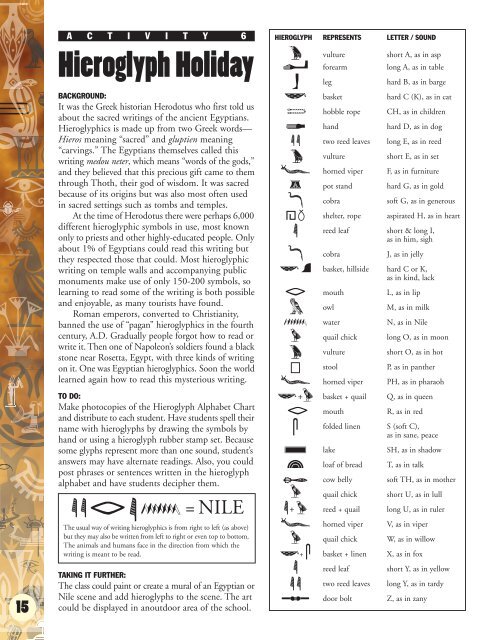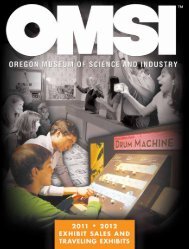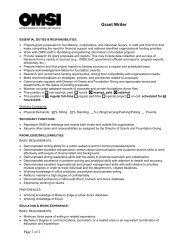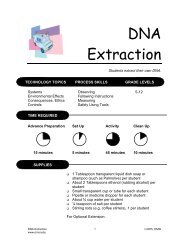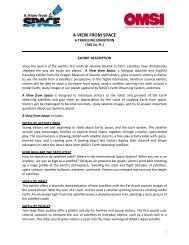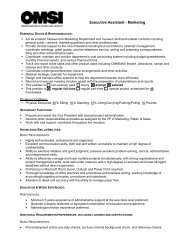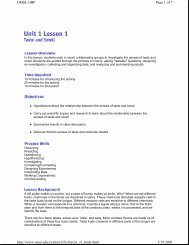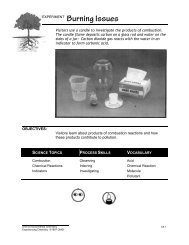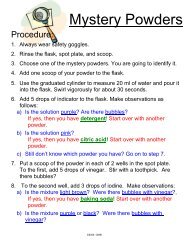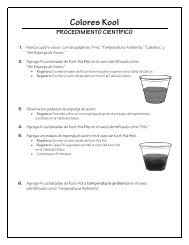You also want an ePaper? Increase the reach of your titles
YUMPU automatically turns print PDFs into web optimized ePapers that Google loves.
15<br />
A C T I V I T Y 6<br />
Hieroglyph Holiday<br />
BACKGROUND:<br />
It was <strong>the</strong> Greek historian Herodotus who first told us<br />
about <strong>the</strong> sacred writings <strong>of</strong> <strong>the</strong> ancient Egyptians.<br />
Hieroglyphics is made up from two Greek words—<br />
Hieros meaning “sacred” and gluptien meaning<br />
“carvings.” The Egyptians <strong>the</strong>mselves called this<br />
writing medou neter, which means “words <strong>of</strong> <strong>the</strong> gods,”<br />
and <strong>the</strong>y believed that this precious gift came to <strong>the</strong>m<br />
through Thoth, <strong>the</strong>ir god <strong>of</strong> wisdom. It was sacred<br />
because <strong>of</strong> its origins but was also most <strong>of</strong>ten used<br />
in sacred settings such as tombs and temples.<br />
At <strong>the</strong> time <strong>of</strong> Herodotus <strong>the</strong>re were perhaps 6,000<br />
different hieroglyphic symbols in use, most known<br />
only to priests and o<strong>the</strong>r highly-educated people. Only<br />
about 1% <strong>of</strong> Egyptians could read this writing but<br />
<strong>the</strong>y respected those that could. Most hieroglyphic<br />
writing on temple walls and accompanying public<br />
monuments make use <strong>of</strong> only 150-200 symbols, so<br />
learning to read some <strong>of</strong> <strong>the</strong> writing is both possible<br />
and enjoyable, as many tourists have found.<br />
Roman emperors, converted to Christianity,<br />
banned <strong>the</strong> use <strong>of</strong> “pagan” hieroglyphics in <strong>the</strong> fourth<br />
century, A.D. Gradually people forgot how to read or<br />
write it. Then one <strong>of</strong> Napoleon’s soldiers found a black<br />
stone near Rosetta, Egypt, with three kinds <strong>of</strong> writing<br />
on it. One was Egyptian hieroglyphics. Soon <strong>the</strong> world<br />
learned again how to read this mysterious writing.<br />
TO DO:<br />
Make photocopies <strong>of</strong> <strong>the</strong> Hieroglyph Alphabet Chart<br />
and distribute to each student. Have students spell <strong>the</strong>ir<br />
name with hieroglyphs by drawing <strong>the</strong> symbols by<br />
hand or using a hieroglyph rubber stamp set. Because<br />
some glyphs represent more than one sound, student’s<br />
answers may have alternate readings. Also, you could<br />
post phrases or sentences written in <strong>the</strong> hieroglyph<br />
alphabet and have students decipher <strong>the</strong>m.<br />
4414p= NILE<br />
The usual way <strong>of</strong> writing hieroglyphics is from right to left (as above)<br />
but <strong>the</strong>y may also be written from left to right or even top to bottom.<br />
The animals and humans face in <strong>the</strong> direction from which <strong>the</strong><br />
writing is meant to be read.<br />
TAKING IT FURTHER:<br />
The class could paint or create a mural <strong>of</strong> an Egyptian or<br />
<strong>Nile</strong> scene and add hieroglyphs to <strong>the</strong> scene. The art<br />
could be displayed in anoutdoor area <strong>of</strong> <strong>the</strong> school.<br />
HIEROGLYPH REPRESENTS LETTER / SOUND<br />
c vulture short A, as in asp<br />
F forearm long A, as in table<br />
R leg hard B, as in barge<br />
X basket hard C (K), as in cat<br />
F hobble rope CH, as in children<br />
@ hand hard D, as in dog<br />
44 two reed leaves long E, as in reed<br />
c vulture short E, as in set<br />
! horned viper F, as in furniture<br />
c pot stand hard G, as in gold<br />
@ cobra s<strong>of</strong>t G, as in generous<br />
]. shelter, rope aspirated H, as in heart<br />
4 reed leaf short & long I,<br />
as in him, sigh<br />
@ cobra J, as in jelly<br />
Xj basket, hillside hard C or K,<br />
as in kind, lack<br />
1 mouth L, as in lip<br />
f owl M, as in milk<br />
p water N, as in <strong>Nile</strong><br />
6 quail chick long O, as in moon<br />
c vulture short O, as in hot<br />
stool<br />
P, as in pan<strong>the</strong>r<br />
! horned viper PH, as in pharaoh<br />
X+6 basket + quail Q, as in queen<br />
1 mouth R, as in red<br />
i<br />
folded linen S (s<strong>of</strong>t C),<br />
as in sane, peace<br />
r lake SH, as in shadow<br />
z loaf <strong>of</strong> bread T, as in talk<br />
J cow belly s<strong>of</strong>t TH, as in mo<strong>the</strong>r<br />
6 quail chick short U, as in lull<br />
4+6 reed + quail long U, as in ruler<br />
! horned viper V, as in viper<br />
6 quail chick W, as in willow<br />
X+i basket + linen<br />
X, as in fox<br />
4 reed leaf short Y, as in yellow<br />
44 two reed leaves long Y, as in tardy<br />
X door bolt Z, as in zany


